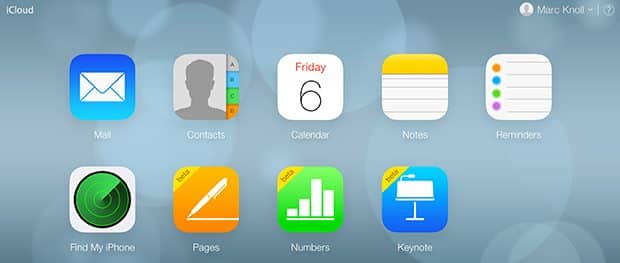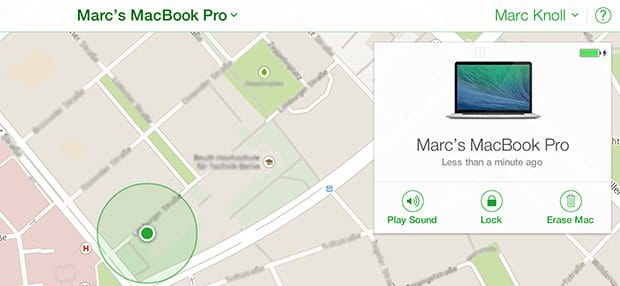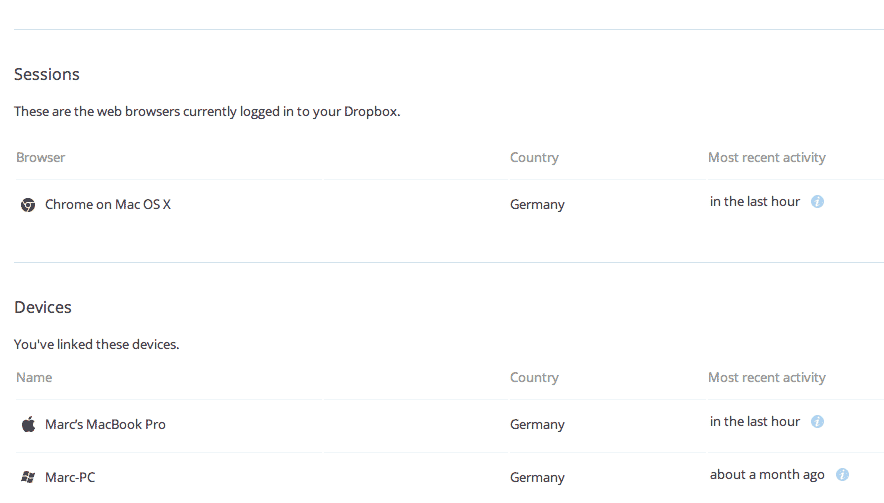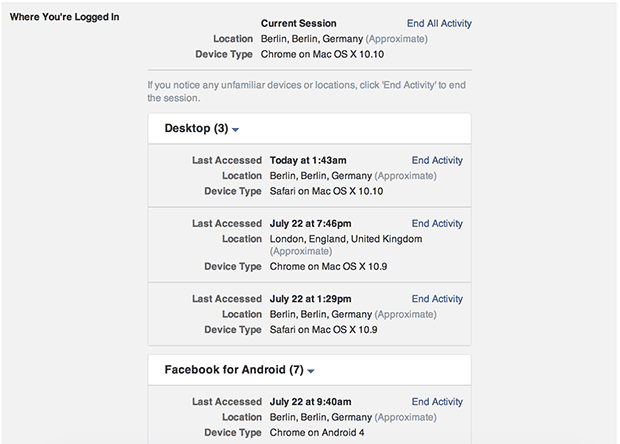So, if you are missing your laptop, don’t lose all your hope just yet. There are a couple of ways to track down your stolen laptop, even without any anti-theft software.
Track your stolen Macbook with iCloud (Mac only)
If you set up and enabled iCloud back when you first started your Macbook (or at any later moment), you can use it to track your macbook. iCloud offers its own integrated anti-theft tool that lets you track your Apple devices, trigger an alarm sound, lock your device or erase all personal data. To get started, go to the iCloud website and log in with your Apple ID.
After clicking on the “Find My iPhone” icon, you should see a map interface and a dropdown menu on the top. Use that menu to choose your missing Macbook. If your Mac is turned on and has an active internet connection, it should show up. In case it isn’t, you can tell iCloud to keep checking and send you a notification as soon as it tracks it down.
Use Dropbox, Facebook or Gmail to get the IP address (Mac & Win)
Some of the applications that constantly run in the background or websites you’re logged into automatically register and store your IP address. If someone uses your laptop and checks out your Facebook profile or emails, you have a good chance of getting the person’s IP address. The problem is that an IP address doesn’t mean that you can easily get the physical address, assigned to the IP. Internet Service Providers (ISPs) have that information but they won’t give it away. You need a warrant for that. So, if you manage to get the IP address of the person using your laptop, go to the police and explain your situation.
Dropbox
The great thing about having Dropbox is that it syncs your data silently in the background (at least if no changes were detected). If someone took your laptop, he or she won’t notice it. Dropbox keeps track of all current and past sessions (or accesses) together with the country of origin and IP address. Log into your account on the Dropbox website, go to Settings and click on the Security tab. Now, you should see a list of the devices that accessed your Dropbox account in the past.
One of these devices should be your laptop. Check the time it last accessed your account. Was it after you lost your laptop? If so, then the IP address possibly belongs to the person who took it. If you want to be sure, wait a while and keep checking for new sessions. If the IP address keeps being the same, you can assume that it belongs to the person’s place. If you have private files in your Dropbox account, I recommend that you change your Dropbox password afterwards. An alternative would be to download your private stuff onto another computer and remove them from your Dropbox account using the browser interface. Then you can continue monitoring the thieves activity without having to worry about any sensitive data.
Gmail
If the person with your laptop is curious enough, he or she might want to take a peek at your mails. As with Dropbox, Gmail keeps track of all the different IP addresses used to access your mails. Go to your Gmail inbox, scroll down and click on “Details” under “Last account activity” in the bottom right corner.
A new window should pop up, displaying the ten last recorded sessions together with the used IP addresses. If you see that someone else accessed your Gmail, you better change your Google account password (after writing down the unknown IP address). You really don’t want someone else to mess with your Google account, especially if you’re using many other Google services.
To get a list of your Facebook account’s sessions, go to Settings and click on Security on the left sidebar. Now click on the bottom item called “Where You’re Logged In” (<– or click this link). You should see an overview of the different devices and apps that last accessed your account. Facebook even tells you the city in which the session was established. If you hover over the city with your cursor, you can see the IP address. You can get an even more detailed lost of basically all past sessions. The way to get there is described in a recent article of mine.
Got the location or IP address? Get help!
Should you be able to get the exact location of your laptop using iCloud or an IP address, don’t head out alone to rescue your laptop. You have no idea who’s sitting in front of it. Contact local authorities and let them check out the address or tell them to get a warrant to get the physical location from the thief’s ISP. If you successfully got your laptop back, please let me know and share your story in the comments!




